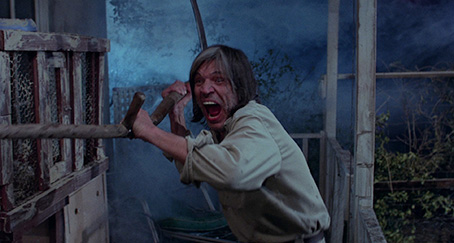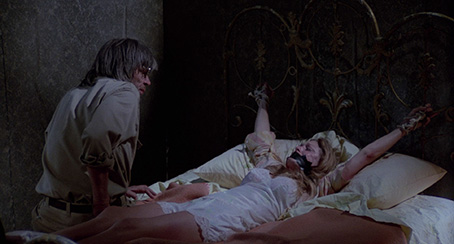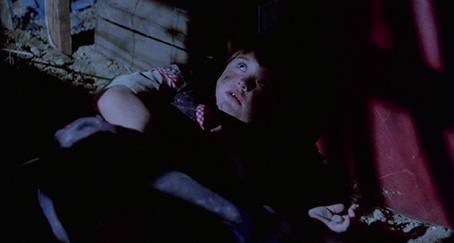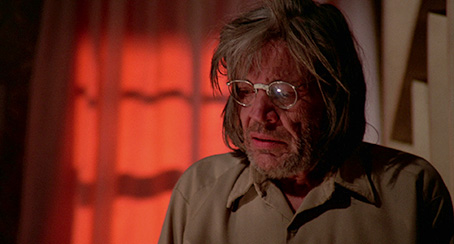|
Imagine the problem. Your breakthrough horror film makes such an impact that it single-handedly transforms the genre. Everyone's waiting to see what you do next and most of them will have unreasonable expectations. If you're going to retain your newly appointed position as a genre god, you'll have to deliver a film that is not just as devastating as the one that made your name, but actually top it. Anything less and you're in for a critical mauling. Fine. Except the chances of pulling this off are so remote that science has yet to come up with an instrument that can accurately measure numbers that small. The problem is that the very things that make a film revolutionary and make it part of the zeitgeist are almost all down to chance. If they weren't we'd be seeing similarly game-changing films released every other week, because every bugger would know how to put one together. The truth is when a movie – particularly a low-budget independent movie – goes box-office and critical ballistic, few are more surprised than the people who made it.
Even with that in mind, back when I first saw Eaten Alive (or Death Trap as it was called in the UK), Tobe Hooper's follow-up to his devastating horror masterpiece The Texas Chain Saw Massacre, I distinctly remember being unsure what to make of it. And yeah, I did go into the cinema with certain expectations, especially once I got a look at the credits. Hooper was directing, Texas Chain Saw alumnus Kim Henkel had worked on the screenplay, Hooper and Wayne Bell had once again composed the score, and brilliant scream queen Marilyn Burns was again high up in the cast list. And the plot involved a murderous, scythe-waving hotel owner and a hungry crocodile that he keeps out back. Oh wow. But Eaten Alive is not The Texas Chain Saw Massacre. Indeed, Eaten Alive is something else entirely.

It begins with fledgling sex worker Clara being chucked out of a brothel by its owner, Miss Hattie, after she refuses the unpleasant advances of a randy dickwad named Buck. With nowhere else to stay, Clara makes her way to the decrepit and isolated Starlight Hotel run by gruff and creepy middle-aged proprietor Judd. She doesn't even make it to her assigned room before it dawns on the psychotically prudish Judd that his guest is one of Miss Hattie's girls. He promptly goes nuts and tries to tear off her clothing. When she fights him off, he knocks her down and stabs her repeatedly with a rake. Not one of those ones you would use to clean up your lawn, but the sort of long-spiked bugger that farm workers might wield if they were due to be painted by Jean-François Millet. And disposing of the body is not really an issue when you have a carnivorous reptile on your property.
From the moment Clara approaches the Starlight Hotel, Eaten Alive is stylistically on a different planet to its celebrated predecessor. Where Texas Chain Saw was shot on location and imbued with a disturbing air of authenticity, Eaten Alive is completely studio based and makes no secret of it. Everything about the hotel and its immediate surroundings is awash with artificiality, from the colour filtered lighting to a physically challenged mechanical croc that appears to only be able to adopt two postures – mouth open or mouth closed. It's clear from the start that Hooper was not aiming for realism here, instead creating the aura of a campfire slasher tale told by the brothers Grimm after waking from a dug-induced nightmare, one set in permanent twilight and located somewhere on the other side of that bridge where the aliens landed in William Cameron Menzies' Invaders from Mars.
As a tension piece the film initially struggles because the full nature of the threat is spelled out at the start and characters are introduced primarily to become fodder for Judd's scythe and his ever-hungry croc. We never really get to know them enough to fret too much for their fate, although they're certainly quirky and diverse enough to be interesting. Top of the tree here are the passing-through couple of Roy and Faye and their daughter Angie, a young girl whose small yappy dog is eaten by the croc and who ends up traumatised by the experience and unable to travel. Mind you, you'd think she'd be familiar with emotional trauma with a father like Roy, whose mental instability is so far off the scale that I'm guessing Faye must have loved him to bits once to even be on the same continent as him now. Ultimately it's young Angie who becomes our point of emotive contact, as she shuts her ears to her parents' bickering, watches in horror as Judd beats her mum senseless, then scurries under the house to be alternately menaced by Judd, some passive rats and the mechanical gator.

In spite of its colourful artificiality and a plot so threadbare you could scribble it on a matchbook, there's something about Eaten Alive that's impossible to resist. From an early stage it seems that Hooper is less interested in spinning a Texas Chain Saw-like tale of unrelenting terror than climbing into the mind of a madman as he suffers a meltdown. His ace in the hole here is the casting of gnarly-faced veteran actor Neville Brand as Judd. Brand throws his all into a character he apparently told Hooper that he really understood (which is about as comforting as that story of Dennis Hopper telling David Lynch that he had to play Frank Booth in Blue Velvet because he was Frank Booth). He is also able to sell Judd as troublingly real as he muddles round the hotel mumbling or singing longingly to himself, or as he bellows angry protestations at the cocksure Buck. When he dances with excitement at his own dreadful misdeeds, it struck me that if the Hitchhiker from Texas Chain Saw had lived to middle age and spent too long on his own, then this is pretty much how he might have turned out. Brand really is a delight here, and armed only with his distinctive features, his lumbering body language, twitchy mannerisms and ferocious bursts of anger, he creates one of the great movie monsters of 70s horror cinema.
Hooper also scores with what now must qualify as one of the cult genre supporting casts of the decade. Roy and Faye, the spectacularly dysfunctional couple who rest up at the hotel after Judd's croc eats Angie's dog, are played by De Palma favourite William Finley and Texas Chain Saw heroine Marilyn Burns. Hooper lets Finley run with the role here and he responds with a performance that appears to be testing the limits of on-screen madness. That said, his most peculiar and seemingly over-the-top moment had real thought behind it, though you'll probably need help from the commentary to realise what it was. Daughter Angie, meanwhile, is played by Kyle Richards, who two years later would play the young charge for babysitters Nancy Loomis and Jamie Lee Curtis in John Carpenter's Halloween (her sister Kim Richards was the girl who was shot through the ice cream in Carpenter's Assault on Precinct 13). Old hands Mel Ferrer, Carolyn Jones and Stuart Whitman are on hand to lend the enterprise a little touch of class, and giving his all as the self-satisfied Buck is Robert Englund, here making his horror mark eight years before he went global as Freddie Krueger in Wes Craven's still glorious A Nightmare on Elm Street.

The extra features on this disc provide a number of frustratingly non-specific hints of the problems that Hooper ran into during the production, and he himself claims that he argued a lot with producer Mardi Rustam. Others have suggested that at one point Hooper walked and that the some sequences were directed by cameraman Robert Caramico, while it's common knowledge that additional material (including the opening brothel scene) was devised and directed by Rustam. Either way, the film still has Hooper's stamp all over it, from the caged monkey that inexplicably curls up and dies in a foreboding prediction of the horror to come, to the same strangely disconcerting use of country-and-western music that underscored the unfolding madness in Texas Chain Saw. There's also a sense of infectious insanity running throughout the film, which peaks with the climactic four-way cross-cutting between the sexually active Buck, the desperate and tied-up Faye, the terrorised Angie and the increasingly agitated Judd, building to a pitch of cinematic near-hysteria that is further fuelled by the almost random abstractions of Hooper and Wayne Bell's electronic score.
A game changer Eaten Alive is not, and in its focus on slaughter at the expense of plot and character depth, it can't help but signal the direction the American horror film was to take during the post-Halloween slasher deluge. But as a dark, surreal and luridly-coloured fairy tale trip into the mouth of homicidal madness, Eaten Alive (sorry, but I still prefer Death Trap as a title, and not just because that's how I first saw it) is still a work that genre fans will have good reason to quietly treasure, and it remains a signature early work of its wildly inventive if frustratingly unpredictable director.
Restored specifically for this release from the orginal camera negative ander the supervision of James White under the guidance of director Tobe Hooper, the 1.85:1 HD transfer transfer vividly recreates how I seem to remember the film looking up on the big screen. Sure, my memory is faulty, but I always recall the vividness of the colour in the tinted lighting, something never really captured by previous home video version the way it has been here. The rich reds and blues in particular would have played merry hell on a VHS transfer and likely bled into the surrounding detail, but there's no hint of over-saturation, colour smudging or digital artefacts here. Detail is impressive and the contrast well balanced when the light allows – both suffer a little when the colour filtered lighting gets extreme (there are whole sequences here that play out in darkroom red, for example), but that's par for the course, and there's more low light detail here than you'll find on previous DVD editions. There's a very faint flickering detectable in places, but most won't even notice it, and the image is largely spotless and stable throughout.

The Linear PCM 2.0 mono track has been transfered from the original 35mm magnetic stripe track and is also in great shape, with clear reproduction of dialogue and effects and particularly the music. There's a slight treble bias to the dialogue recording but the dynamic range is slightly fuller than expected.
Interviews
The three new interviews here were shot specifically for this Arrow release.
Blood on the Bayou – An Interview with Tobe Hooper (14:03)
The wonderfully grizzle-voiced Hooper recalls how he came to this particular project and throws in a few intriguing anecdotes about its making (Judd was partly based on America's oldest man, who claimed he kept healthy by snorting stomach powder). There are hints of the problems he encountered during the production ("suggestions imposed on me that didn't jibe"), and the move from lightweight hand-held 16mm cameras to heavyweight 35mm Mitchells clearly impacted on his directing style. Interesting to hear that it took him some time to realise him that people wanted to work with him specifically because of Texas Chain Saw.
Gator Bait: An interview with Janus Blythe (11:38)
Actor Janus Blythe recalls getting her role in the film, her disappointment at not being directed by Hooper (who by this point had apparently left the production), and landing parts in fellow cult favourites The Hills Have Eyes and The Incredible Melting Man. She bemoans the paucity of decent role for young female actors at the time ("it was all T&A") and briefly discusses her TV interview show, one of whose guests in the included clips is Wes Craven.
Monsters and Metaphors: An Interview with Craig Reardon (11:25)
The whip-smart Craig Readon – the film's make-up artist and a man the American government should appoint immediately as Ambassador for Horror – discusses Eaten Alive almost in passing in his fascinating analysis of film trends of the period and his recollection of how news of the Manson murders felt like the end of western civilisation. He has some interesting comments on Neville Brand, an actor he describes as being "a picture of someone you wouldn't want to mess with" in his youth, then suggesting that when he got older he looked the same, "but sand-blasted."

Archive Interviews
The three interviews in this section have all been sourced from the 2007 2-disc Special Edition US DVD from Dark Sky Films.
The Gator Creator with Tobe Hooper (19:38)
Hooper talks about being the first of the Austin filmmakers to make his mark, how he came to the project, searching for locations (this one is rather fun), the decision to shoot the whole film on a sound stage, selecting and working with the cast, and a whole lot more. There's an amusing story about what happened when the fake crocodile was left in the water tank overnight, and there are further hints that the shoot wasn't the happiest experience for him. He nonetheless remains pragmatic about the project, describing himself as a gun for hire and accepting that he was making a grindhouse movie. "It's not going to be part of the permanent collection at the Museum of Modern Art," he says with a wry grin.
My name is Buck: Robert Englund (15:05)
Following a good natured spoiler warning, the affable Englund takes us on a comprehensive trip though his early acting career, then discusses the attraction of working with veteran actors Stuart Whitman, Mel Ferrer, Carolyn Jones and Neville Brand, the communication shorthand he developed with Tobe Hooper, his efforts to sell the artificial crocodile as real, and more. He amusingly describes the film as "good cheesy."
5ive Minutes with Marilyn Burns (5:18)
In a brief but welcome chat, Marilyn Burns recalls reuniting with Hooper, and working with William Finley ("a great actor and terrific to work with"), Neville Brand ("He scared me a lot at times") and the vintage trio of Mel Ferrer, Caroline Jones and Stuart Whitman.

The Butcher of Elmendorf (23:05)
Also sourced from the Dark Sky DVD, this straightforward but interesting 2006 featurette explores the true-life story of South Texas bar owner and serial killer Joe Ball, who was the partial inspiration for the character of Judd in Eaten Alive. Built primarily around an interview with Ball's nephew Richard 'Bucky' Ball, with assistance from archive stills and footage and a fair amount of gap-filling text, it outlines Ball's life and crimes, as well as the myth-making exaggerations of his story that followed.
Trailers
Quite a few here, but not a lot a variance in the content and voice over. The Death Trap Green Band (1:06) and the Eaten Alive Green Band (1:12) are basically the same thing with a different title. Similarly twinned are the Death Trap Red Band (2:10) and the Eaten Alive Red Band (2:14). All four sport pretty much the same po-faced narration and the bold claim that "What happens in Eaten Alive will give you the most chilling, terrifying 90 minutes you've ever spent in a theatre." This serious voice is back for the longer Starlight Slaughter (2:43) trailer, which swaps Jaws for Psycho as the comparative film, and a different narrator is given roughly the same script for the Horror Hotel (1:42) trailer. Best of all is the Death Trap Japanese Trailer (2:28), which has an altogether more excitable narrator and the Japanese title of 'The Devil's Swamp'.
There are also two Starlight Slaughter TV Spots (0:36 each) and two Eaten Alive Radio Spots (0:37 and 1:05). All are based on the green band trailers above.
Alternate Credits (1:05) are roughly the same as those on the film as it stands but with Death Trap as the title.
Galleries
Behind the Scenes Slideshow (8:09)
A rolling gallery of behind-the-scenes stills set to music from the film, which includes some offbeat moments of relaxation and humour.
Stills and Promo Material
Posters, photos, front-of-house stills and pages from press books. This one is manually advanced using the remote control.
Comment Cards
An eye-opening inclusion consisting of scans of comment cards from a preview screening of the film. Some of the reactions are pretty hostile – "Burn it," "Horrible sick," "Depraved" – while requests for suggestions for alternative titles include "Scream," "Crocodile Rock" (oh that is funny) and – would you believe it? – "Starlight Slaughter." One other illiterate wag proposes the title, "To never be release." Up yours, dimwit.

Commentary
Another import from the Dark Sky DVD and a most welcome one, particularly given that one of the contributors (all of whom have been recorded separately and edited together) is actor William Finley, who is no longer with us. Producer Mardi Rustam outlines how the film came to be, how director of photography Robert Caramico joined and stayed with the project, the work of the actors and his clear admiration for Tobe Hooper, who is tellingly absent from this particular extra. William Finley recalls how he landed the role of Roy and usefully deconstructs the thinking behind the wilder elements of his performance. He describes Kyle Richards as the best screamer he's ever heard, and remembers his concern about a trimmed fight scene with a sometimes scary Neville Brand and states in all seriousness, "You have a man who is trying to act as if he is mentally unstable and a man who may have been mentally unstable." Make-up artist Craig Reardon reveals how he landed a job that he was then largely prevented from doing (the man he was called in to replace blocked all attempts to remove him), has some positive memories of Neville Brand, and contributes to the mystery surrounding Hooper's still unexplained departure from the film. Actress Roberta Collins has fond memories of working with Neville Brand, at least until he invited her to his house for dinner and things got a little weird (I'll leave it to her to elaborate on that one). Kyle Richards remembers her role in the film as being the toughest and scariest she ever had, the complete opposite of the fun time she had on Halloween. Oh there's loads more here. An essential companion to the film.
Booklet
The main feature of this most attractively produced booklet is a detailed, well argued and researched essay titled After the Saw: Tobe Hooper's Eaten Alive by Brad Stevens, one that's thoughtfully headed with a spoiler warning. Production credits, details of the restoration, still and a poster for the film under the title of Horror Hotel are also included.
Go in expecting a rerun of The Texas Chain Saw Massacre and you're likely to be bemused. Then again, there aren't many films you could watch to adequately prepare you for what Hooper serves up here. Definitely one for the horror faithful, it's once again been elevated to the status of must-have through its exemplary presentation, with a sparkling transfer backed by a sleazy hotel full of splendid extra features. For cult horror fans at least, highly recommended.
|